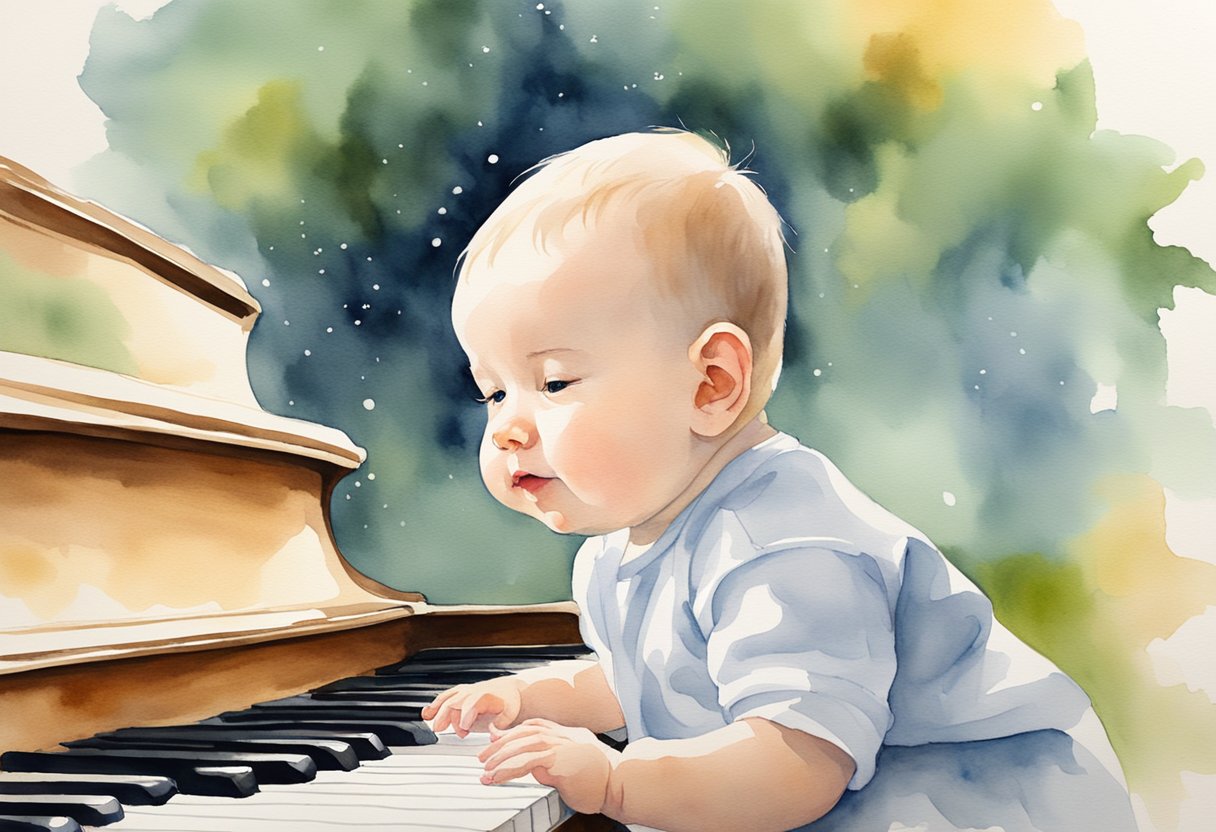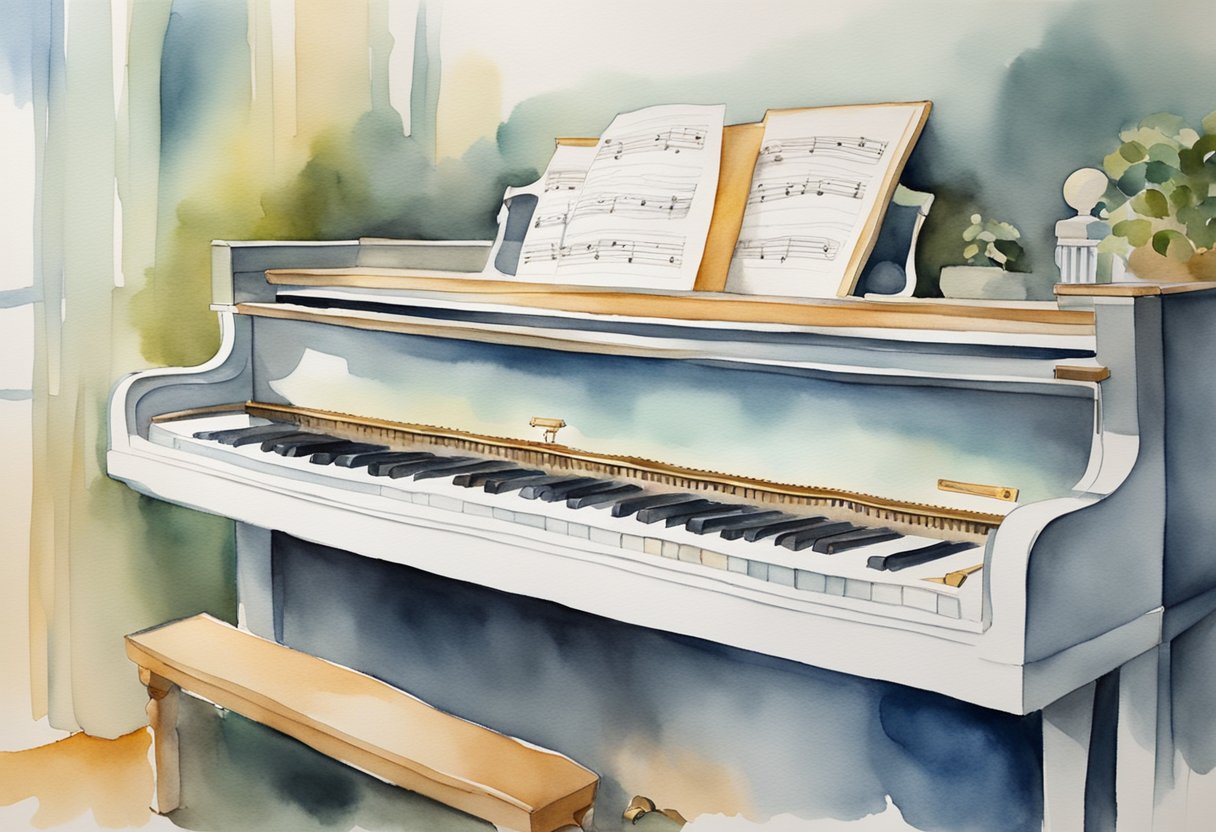As an Amazon Associate I earn from qualifying purchases.
Playing the piano can be an enriching experience for both you and your baby, but it’s important to consider their delicate hearing. As someone who not only teaches piano but also explores the joy of music with children, I’m aware that a baby’s ear canal is smaller and thus more sensitive, which can make them more susceptible to hearing damage.
It’s a concern many parents and educators share, and I’ve personally seen the need to monitor the volume and duration of musical exposure in young children.
Want to Learn Piano?Click Here

That said, it’s not necessary to completely avoid the piano around your infant. In fact, listening to piano music can have many benefits, including the potential to improve cognitive development and attention span.
The key is moderation and ensuring that the sound levels are appropriate. You’ll want to ensure the environment is calm, the volume is low, the baby is not close to the instrument, and the sessions are brief – usually no more than 5-10 minutes at a time.
To protect your baby’s hearing while still exposing them to the beauty of piano music, you can take simple steps like playing with a softer touch or using a keyboard with volume control. Over time, you’ll learn to gauge your baby’s reaction to different volumes and types of piano music, further tailoring the experience to their comfort and enjoyment.
Understanding Piano Volume and Baby Safety

When it comes to enjoying music with your little one, it’s important to be mindful of the volume—especially with instruments like the piano that can vary greatly in sound levels.
Assessing Sound Levels of Different Pianos
Upright pianos and grand pianos have different characteristics in terms of soundboard size and sound projection. An upright piano often has a smaller soundboard and can project sound directly towards a solid wall, typically making it somewhat quieter.
In contrast, a grand piano has a larger soundboard with sound that projects upwards and outwards, filling up the space, and can often be louder. Since decibels measure the intensity of sound, it’s useful to know that normal piano playing can vary between 60-70 decibels, but forte passages can exceed 80 decibels, nearing levels that may be risky to your infant’s ears without proper precautions.
Identifying Signs of Discomfort in Babies
Watch for cues your baby might give if the music is too loud for them, such as turning their head away, crying, or becoming fussy.
These signs of discomfort are crucial in understanding their tolerance. Babies’ ear canals are smaller, making them more sensitive to sounds. Repeated exposure to loud sounds can affect their hearing, which in turn, can impact language development.
Protective Measures for Safer Listening
Simple protective measures can make a world of difference. Consider placing your piano against a reflective surface to diffuse the sound, or use a rug beneath the piano to absorb excess sound. During play, you can partially close the lid on a grand piano or use the soft pedal to minimize volume.
Monitor both the length and volume of your baby’s exposure. Implementing these strategies helps protect your baby’s ears, while still allowing them to experience the joy of music.
Adjusting Piano Environment and Play for Babies
When you introduce your baby to the world of piano music, careful adjustments to the environment and the instrument itself can make it a delightful experience for their delicate ears.
Techniques to Reduce Piano Volume
Close the Lid: One simple measure is to close the grand piano’s lid or utilize the music rack on upright pianos to direct the sound away from your baby. This is a direct way to manage the volume without altering the tune or key of the music.
Practice Pedal: Most pianos have a practice pedal that inserts a piece of dampening material between the hammers and strings, significantly reducing the volume.
Silent Systems: For those who own an acoustic piano, consider installing a silent system. This technology stops the hammers from hitting the strings and instead plays a digital recording of a piano through headphones, perfect for maintaining a quiet environment.
Carpeted Area: Placing your piano in a carpeted area can naturally absorb some of the sound, helping to make it quieter.
Choosing the Right Time and Duration for Play
Time: Opt for moments when your baby is alert and receptive, but not overstimulated. This might be after a nap or a feeding.
Duration: Limit the exposure to piano music to short sessions, about 5-10 minutes at a time. As babies have smaller ear canals, they can be more sensitive to sounds, so it’s crucial to monitor their reactions and adjust accordingly.
Creating a Baby-Friendly Musical Space
Digital Piano: If you’re concerned about volume control, a digital piano or keyboard may be an excellent option as they allow for precise volume control and even headphone use.
Temperature: Ensure the room’s temperature is comfortable for your baby. Too hot or too cold, and their focus might leave the joy of the music.
Windows: If your piano is situated near a window, consider using curtains to dampen any external noise, so your baby enjoys the piano without distraction.
Remember, the goal is to make piano playtime with your baby a soothing and enjoyable experience. So, take your time to craft the perfect musical environment for your little one.
Hello & thanks for stopping by! I’m a professional concert pianist and piano instructor. In the United States, I’ve given successful performances in several places including New York, Florida, Connecticut, & New Jersey, I have also performed internationally in Italy and made my Carnegie Hall debut in 2014. I enjoy blogging about the piano, the art of performance, general music, current events and the latest in music production.
